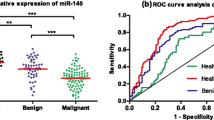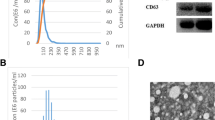Abstract
Epithelium ovarian cancer (EOC) is currently the prevalent malignant cancer worldwide. However, there is a lack of efficient biomarkers for EOC screening. Accumulating evidence reveals that serum miRNA detectable in various types of cancer. Therefore, we explore the diagnostic value of combined detection of plasma miR-193a-5p, HE4 and CA125 for EOC. Serum samples were collected from 45 patients with primary EOC, 30 patients with benign ovarian tumor patients and 40 healthy controls. The expression of serum miR-193a-5p was detected by real-time quantitative PCR, and serum HE4 and CA125 were detected by chemiluminescent immunoassay. Moreover, a diagnostic model combining miR-193a-5p, HE4 and CA125 or alone in EOC patients was evaluated by ROC curve analysis. The relative expression quantity (RQ) of serum miR-193a-5p in EOC patients, benign ovarian tumor patients and healthy control groups were 0.419 (0.093, 2.215), 3.667 (1.633, 6.691) and 1.130 (1.000, 7.087), respectively. The RQ of serum miR-193a-5p in EOC patients was significantly lower than that in benign ovarian tumor patients and healthy controls (both P < 0.001), and there was no significant difference between benign ovarian tumor patients and healthy controls (both P > 0.05). There was no significant correlation between serum miR-193-5p, HE4 and CA125 levels (both P > 0.05). Additionally a risk model for miR-193a-5p, HE4 and CA125 was correlated with Grading and Lymph node metastasis (P = 0.016, P = 0.029). The area under the receiver operating characteristic curve of a risk model for distinguishing EOC patients from healthy individuals was 0.996, which higher than any single biomarker. Combined detection of miR-193-5p, HE4 and CA125 by logistic regression analysis could greatly improved the diagnostic ability of EOC and may prove to be a candidate biomarker, providing new directions for further investigation.


Similar content being viewed by others
References
Siegel RL, Miller KD, Jemal A (2015) Cancer statistics, 2015. CA Cancer J Clin 65(1):5–29
Meinhold-Heerlein I, Hauptmann S (2014) The heterogeneity of ovarian cancer. Arch Gynecol Obstet 289(2):237–239
Anderson GL, McIntosh M, Wu L, Barnett M, Goodman G, Thorpe JD, Bergan L, Thornquist MD, Scholler N, Kim N, O'Briant K, Drescher C, Urban N (2010) Assessing lead time of selected ovarian cancer biomarkers: a nested case-control study. J Natl Cancer Inst 102(1):26–38
Bartel DP (2009) MicroRNAs: target recognition and regulatory functions. Cell 136(2):215–233
Shapira I, Oswald M, Lovecchio J, Khalili H, Menzin A, Whyte J, Dos Santos L, Liang S, Bhuiya T, Keogh M, Mason C, Sultan K, Budman D, Gregersen PK, Lee AT (2014) Circulating biomarkers for detection of ovarian cancer and predicting cancer outcomes. Br J Cancer 110(4):976–983
Wu H, Xiao Z, Wang K, Liu W, Hao Q (2013) MiR-145 is downregulated in human ovarian cancer and modulates cell growth and invasion by targeting p70S6K1 and MUC1. Biochem Biophys Res Commun 441(4):693–700
Petrillo M, Zannoni GF, Beltrame L, Martinelli E, DiFeo A, Paracchini L, Craparotta I, Mannarino L, Vizzielli G, Scambia G, D'Incalci M, Romualdi C, Marchini S (2016) Identification of high-grade serous ovarian cancer miRNA species associated with survival and drug response in patients receiving neoadjuvant chemotherapy: a retrospective longitudinal analysis using matched tumor biopsies. Ann Oncol 27(4):625–634
Zhang H, Wang Q, Zhao Q, Di W (2013) MiR-124 inhibits the migration and invasion of ovarian cancer cells by targeting SphK1. J Ovarian Res 6(1):84
Montagnana M, Benati M, Danese E (2017) Circulating biomarkers in epithelial ovarian cancer diagnosis: from present to future perspective. Ann Transl Med 5(13):276
Mahdian-Shakib A, Dorostkar R, Tat M, Hashemzadeh MS, Saidi N (2016) Differential role of microRNAs in prognosis, diagnosis, and therapy of ovarian cancer. Biomed Pharmacother 84:592–600
Zhou J, Duan H, Xie Y, Ning Y, Zhang X, Hui N, Wang C, Zhang J, Zhou J (2016) MiR-193a-5p targets the coding region of AP-2α mRNA and induces cisplatin resistance in bladder cancers. J Cancer 7(12):1740–1746
Lin CH, Tsai CH, Yeh CT, Liang JL, Hung WC, Lin FC, Chang WL, Li HY, Yao YC, Hsu TI, Lee YC, Wang YC, Sheu BS, Lai WW, Calkins MJ, Hsiao M, Lu PJ (2016) MiR-193a-5p/ERBB2 act as concurrent chemoradiation therapy response indicator of esophageal squamous cell carcinoma. Oncotarget 7(26):39680–39693
Yu T, Li J, Yan M, Liu L, Lin H, Zhao F, Sun L, Zhang Y, Cui Y, Zhang F, Li J, He X, Yao M (2015) MicroRNA-193a-3p and -5p suppress the metastasis of human non-small-cell lung cancer by downregulating the ERBB4/PIK3R3/mTOR/S6K2 signaling pathway. Oncogene 34(4):413–423
Wang X, Cao L, Wang Y, Wang X, Liu N, You Y (2012) Regulation of let-7 and its target oncogenes (review). Oncol Lett 3:955–960
Gregory PA, Bert AG, Paterson EL, Barry SC, Tsykin A, Farshid G, Vadas MA, Khew-Goodall Y, Goodall GJ (2008) The miR-200 family and miR-205 regulate epithelial to mesenchymal transition by targeting ZEB1 and SIP1. Nat Cell Biol 10(5):593–601
Lou Y, Yang X, Wang F, Cui Z, Huang Y (2010) MicroRNA-21 promotes the cell proliferation, invasion and migration abilities in ovarian epithelial carcinomas through inhibiting the expression of PTEN protein. Int J Mol Med 26:819–827
Nakano H, Yamada Y, Miyazawa T, Yoshida T (2013) Gain-of-function microRNA screens identify miR-193a regulating proliferation and apoptosis in epithelial ovarian cancer cells. Int J Oncol 42:1875–1882
Wang C, Ding M, Xia M, Chen S, Van Le A, Soto-Gil R, Shen Y, Wang N, Wang J, Gu W, Wang X, Zhang Y, Zen K, Chen X, Zhang C, Zhang CY (2015) A five-miRNA panel identified from a multicentric case-control study serves as a novel diagnostic tool for ethnically diverse non-small-cell lung cancer patients. EBioMedicine 2(10):1377–1385
Dong H, Wang C, Lu S, Yu C, Huang L, Feng W, Xu H, Chen X, Zen K, Yan Q, Liu W, Zhang C, Zhang CY (2016) A panel of four decreased serum microRNAs as a novel biomarker for early Parkinson's disease. Biomarkers 21(2):129–137
Prinsloo A, Pool R, Van Niekerk C (2017) Preliminary data on microRNA expression profiles in a group of south African patients diagnosed with chronic myeloid leukaemia. Mol Clin Oncol 7(3):386–390
Duffy MJ, Bonfrer JM, Kulpa J, Rustin GJ, Soletormos G, Torre GC, Tuxen MK, Zwirner M (2005) CA125 in ovarian cancer: European group on tumor markers guidelines for clinical use. Int J Gynecol Cancer 15(5):679–691
Cho HY, Park SH, Park YH, Kim HB, Kang JB, Hong SH, Kyung MS (2015) Comparison of HE4, CA125, and risk of ovarian malignancy algorithm in the prediction of ovarian cancer in Korean women. J Korean Med Sci 30(12):1777–1783
Piovano E, Attamante L, Macchi C, Cavallero C, Romagnolo C, Maggino T, Landoni F, Gadducci A, Sartori E, Gion M, Zola P (2014) The role of HE4 in ovarian cancer follow-up: a review. Int J Gynecol Cancer 24(8):1359–1365
Acknowledgements
XJR and HZ carried out the PCR assay and drafted the manuscript. SQJ and XJS conceived of the study, participated in its design and coordination. XJS and HBN analyze the data. HC and XDW revised the manuscript.
Author information
Authors and Affiliations
Corresponding authors
Ethics declarations
Grand Support
The National Nature Science Foundation of China (81,672,099; 81,271,920); Jiangsu Provincial Medical Innovation Team and Leading Talents (LJ201133); the Scientific Research Subject of Jiangsu Provincial Health Department (H201422; H201526); and translational medicine project of Affiliated Hospital of Nantong University (TDF-zh201407, TDF-zh201406).
Ethical Approval
All samples in the manuscript were anonymous and the study protocol was approved by the local ethics committee.
Additional information
Xiaojuan Ren and Hui Zhang are the Co-first author.
Rights and permissions
About this article
Cite this article
Ren, X., Zhang, H., Cong, H. et al. Diagnostic Model of Serum miR-193a-5p, HE4 and CA125 Improves the Diagnostic Efficacy of Epithelium Ovarian Cancer. Pathol. Oncol. Res. 24, 739–744 (2018). https://doi.org/10.1007/s12253-018-0392-x
Received:
Accepted:
Published:
Issue Date:
DOI: https://doi.org/10.1007/s12253-018-0392-x




